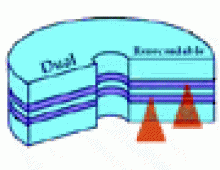
JVC Announces Availability of First Dual Layer DVD-RW Discs
JVC today announced second quarter availability of the first single-sided, dual layer DVD-RW discs, in both standard and Mini DVD 2x speed versions. JVC is among the first to develop rewritable capability for these discs.
The first two products to incorporate this technology are a 2x speed DVD-RW standard disc with a capacity of 8.5GB, for a recording time of up to 215 minutes, and a 2x speed 8cm Mini DVD for use in DVD camcorders. It has a capacity of 2.6GB, for up to 60 minutes of recording time.
Adding the rewritable feature to a single-sided, dual layer disc was made possible by JVC's development of a high-sensitive recording film, a new recording method that enhances erasability, and a proprietary precision thin film forming technology. JVC also developed a facing film bonding method that enables mass production of the new discs using conventional manufacturing equipment.
Features of JVC's Single-Sided, Dual Layer DVD-RW Disc Technology JVC's dual layer DVD-RW disc technology utilizes a semi-transparent first recording layer (L0 layer) with high transmission performance from the signal read side. With conventional DVD-RW disc technology, the use of a thinner recording layer in order to achieve improved transmission performance results in less laser beam absorption. The drop in laser absorption is insufficient to form and erase marks (recording signal patterns). JVC's new single-sided, dual layer DVD-RW disc technology makes use of a new high sensitive recording film that allow excellent transmission performance and signal rewritability, and a new recording method, "N-Strategy", which enhances erasability. The high sensitive recording film and "N-Strategy" are based on JVC's proprietary phase-change design technology developed for high speed DVD-RW discs. Furthermore, JVC employs precision thin film forming technology based on nanotechnology.
In addition, JVC developed a facing film bonding method in which the L1 and L0 recording layers are each formed on a separate substrate, but use a different forming order. The recording sides formed on each recording layer are then bonded in an opposed fashion, separated by a space layer. The two recording layers are manufactured as separate processes prior to bonding, resulting in improved production efficiency and mass production capability using conventional manufacturing equipment.
Despite the acceptable overall optical characteristics of the new media, JVC does not clarify whether they comply to the DVD standard. Considering that phase-change materials have a much higher absorption than the dyes in write-once discs, it would be the DVD-RW dual-layer media to be out of the DVD standard. For example, the reflectivity of such a dual layer disk could be an issue. In that case, a firmware upgrade in the existing DVD players/writers would be essential. Of course, small variations of the optical characterisitcs are within the tolearnce of hardware, so no compatibility issues with current DVD readers would occur.
Adding the rewritable feature to a single-sided, dual layer disc was made possible by JVC's development of a high-sensitive recording film, a new recording method that enhances erasability, and a proprietary precision thin film forming technology. JVC also developed a facing film bonding method that enables mass production of the new discs using conventional manufacturing equipment.
Features of JVC's Single-Sided, Dual Layer DVD-RW Disc Technology JVC's dual layer DVD-RW disc technology utilizes a semi-transparent first recording layer (L0 layer) with high transmission performance from the signal read side. With conventional DVD-RW disc technology, the use of a thinner recording layer in order to achieve improved transmission performance results in less laser beam absorption. The drop in laser absorption is insufficient to form and erase marks (recording signal patterns). JVC's new single-sided, dual layer DVD-RW disc technology makes use of a new high sensitive recording film that allow excellent transmission performance and signal rewritability, and a new recording method, "N-Strategy", which enhances erasability. The high sensitive recording film and "N-Strategy" are based on JVC's proprietary phase-change design technology developed for high speed DVD-RW discs. Furthermore, JVC employs precision thin film forming technology based on nanotechnology.
In addition, JVC developed a facing film bonding method in which the L1 and L0 recording layers are each formed on a separate substrate, but use a different forming order. The recording sides formed on each recording layer are then bonded in an opposed fashion, separated by a space layer. The two recording layers are manufactured as separate processes prior to bonding, resulting in improved production efficiency and mass production capability using conventional manufacturing equipment.
Despite the acceptable overall optical characteristics of the new media, JVC does not clarify whether they comply to the DVD standard. Considering that phase-change materials have a much higher absorption than the dyes in write-once discs, it would be the DVD-RW dual-layer media to be out of the DVD standard. For example, the reflectivity of such a dual layer disk could be an issue. In that case, a firmware upgrade in the existing DVD players/writers would be essential. Of course, small variations of the optical characterisitcs are within the tolearnce of hardware, so no compatibility issues with current DVD readers would occur.




















